| Pages:
1
2
3 |
jamit
Hazard to Others
  
Posts: 375
Registered: 18-6-2010
Location: Midwest USA
Member Is Offline
Mood: No Mood
|
|
copper II chloride crystals
I find copper II chloride fascinating, particularly, its various stages of hydration.
I made copper chloride using copper carbonate and hydrochloric acid but here's my dilemma: Its so hard to make transparent crystals out of them. I
was able to get transparent blue crystals out of them once but I haven't been able to duplicate the result since.
After filtering to get a clear solution of copper chloride. I allow it to evaporate slowly at room temp and all I get is this bright green power at
the bottom.
If you wash this green powder in water, for a moment, it turns blue, and you can quickly separate it and dry to get blue crystals. It's not as blue
as copper sulfate but clearly the copper chloride can have a transparent blue color.
Has anyone had any similar experience working with copper chloride?
I've dried the green copper chloride in an oven and obtains the anhydrous brown color.
So my experience has been that copper chloride exist in at least three forms:
1. Anhydrous copper chloride (brown) - made from hydrous copper chloride (green)
2. various hydrous forms of green copper chloride - I've read that this green is the result of excess chloride ions (see wiki)
3. blue crystalline (transparent) copper chloride that was washed with distilled water.
I would love to hear from anyone who has actually done some work on copper chloride and if you could share your findings... I would appreciate it very
much. thanks.
[Edited on 31-1-2012 by jamit]
[Edited on 31-1-2012 by jamit]
|
|
|
MrHomeScientist
International Hazard
    
Posts: 1806
Registered: 24-10-2010
Location: Flerovium
Member Is Offline
Mood: No Mood
|
|
I did one experiment a while back to test wiki's claim of the green color, and found that it is in fact true. I made copper(II) chloride basically the
same way you did, going from CuSO4 -> CuCO3 -> CuCl2. The final CuCl2 solution was a deep green. I then took a small amount of the solution and
diluted it with some water, and the color changed to light blue as the concentration decreased. Then, I added a small amount of ammonium chloride to
this solution and stirred to dissolve, and the green color returned!
I made another light blue solution, then poured both that and the ammonium chloride-ed green solution onto watch glasses to let them evaporate. I now
have two batches of copper chloride crystals, one green and one light blue!
|
|
|
LanthanumK
Hazard to Others
  
Posts: 298
Registered: 20-5-2011
Location: New Jersey
Member Is Offline
Mood: No Mood
|
|
When I dry a highly acidic solution of copper(II) chloride, it dries as green crystals which smell like HCl.
hibernating...
|
|
|
bbartlog
International Hazard
    
Posts: 1139
Registered: 27-8-2009
Location: Unmoored in time
Member Is Offline
Mood: No Mood
|
|
It's possible that the blue form is some sort of nonstoichiometric oxychloride. CuCl2 is a fairly weak lewis acid but under the right conditions I
think you could still see a little bit of CuCl2 + H2O -> Cu(OH)Cl + HCl.
The less you bet, the more you lose when you win.
|
|
|
LanthanumK
Hazard to Others
  
Posts: 298
Registered: 20-5-2011
Location: New Jersey
Member Is Offline
Mood: No Mood
|
|
I think the green form is an acidic species of CuCl2, and the blue salt is the normal salt. Hydrolysis would probably result in an insoluble residue,
which is not seen with blue CuCl2 (I possess both forms).
hibernating...
|
|
|
jamit
Hazard to Others
  
Posts: 375
Registered: 18-6-2010
Location: Midwest USA
Member Is Offline
Mood: No Mood
|
|
Correct me if I'm wrong but the green crystals of cucl2 (more acidic) are long needle like crystals, whereas the blue colored cucl2 is more cubical...
Which is quite surprising. Does any concurr with my description of the crystals structure of copper II chloride?
|
|
|
LanthanumK
Hazard to Others
  
Posts: 298
Registered: 20-5-2011
Location: New Jersey
Member Is Offline
Mood: No Mood
|
|
All copper(II) chloride crystals, AFAIK, are needle-shaped.
The picture is a comparison of green copper(II) chloride with normal copper(II) sulfate.

hibernating...
|
|
|
jamit
Hazard to Others
  
Posts: 375
Registered: 18-6-2010
Location: Midwest USA
Member Is Offline
Mood: No Mood
|
|
I agree that the green crystals are needle shaped. But have you ever tried to do a quick cold wash with distilled water and then quickly dry it?
You get blue crystals like the one you see on the far right.
So here's my three forms of copper II chloride (from left to right): copper II chloride (+chloride), anhydrous copper II chloride, and copper II
chloride (washed in water).
If you dissolve the green crystals, it turns the water solution blue. So there must be a way to get blue copper II chloride crystals. I just don't
know how? Can someone help?
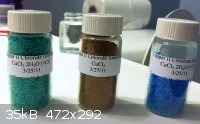
|
|
|
Poppy
Hazard to Others
  
Posts: 294
Registered: 3-11-2011
Member Is Offline
Mood: † chemical zombie
|
|
Smash de green crystals very finely. then add a small ammount of water, keep the salt and the water in an near to equilibrium by heating the mikxture
until near total dissolution, this might syntherize the crystals into bigger ones, but this would take time, and probably pH control (anionic strenght
since thats what differs the colors)
|
|
|
woelen
Super Administrator
        
Posts: 8079
Registered: 20-8-2005
Location: Netherlands
Member Is Offline
Mood: interested
|
|
Pure copper(II)chloride dihydrate is blue/green, more like cyan. It has needle-like crystals.
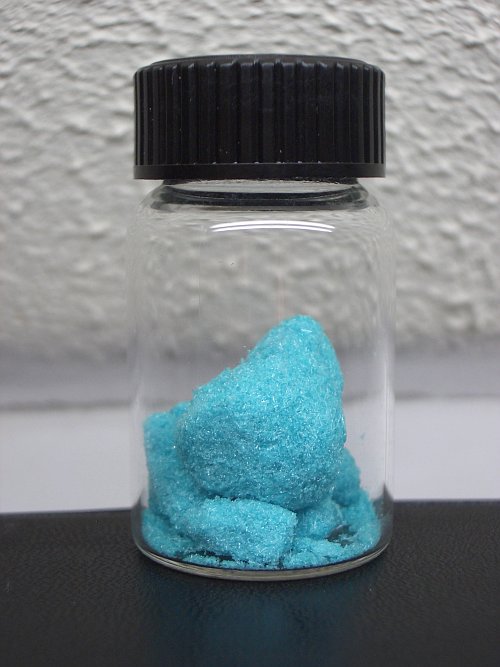
The picture shows a commercial sample of reagent grade CuCl2.2H2O.
The grass-green compound is an acidic compound, which contains HCl as well. It contains complexes like HCuCl3.xH2O and these cause the green color.
|
|
|
jamit
Hazard to Others
  
Posts: 375
Registered: 18-6-2010
Location: Midwest USA
Member Is Offline
Mood: No Mood
|
|
Thanks Woelen! I was waiting for your input on this subject knowing that you have done a lot of work on copper based compounds.
But could you comment on what you think I have above in the three vials. So the green vial on the far left is HCI contaminated and has various
complexes? What about the middle vial? Is it anhydrous of the vial on the left with HCI contaminants?
And more importantly, what do you make of the vial on the far right? These are not needle like crystals. When you add the green crystals to water
they turn the solution blue. Have you ever tried a quick wash of the green crystals and then dried them on a paper towel? They turn blue.
My question is, 'what do I have on the far right vial since I've wash it with water and the crystals are blue'?
Your commercial sample of blue/green crystal -- how do you make that at home?
I don't think you have any experiment on your website on copper II chloride synthesis or do you?
anyway, i would love to hear back from you on your thoughts! thanks.
|
|
|
zoombafu
Hazard to Others
  
Posts: 255
Registered: 21-11-2011
Location: U.S.
Member Is Offline
Mood: sciencey
|
|
I do believe that the middle is the anhydrous CuCl2, as it is the right color and the crystals look right from my experience. However I have not made
the needle like crystals, those must be the super pure from. To get them you would (most likely) have to do a recrystallization. Ill try this in the
near future, and post my findings on this thread.
[Edited on 9-2-2012 by zoombafu]
|
|
|
jamit
Hazard to Others
  
Posts: 375
Registered: 18-6-2010
Location: Midwest USA
Member Is Offline
Mood: No Mood
|
|
Thanks Zoombafu for your input. However, I'm looking for answers from those who have actually attempted to make copper II chloride and its anhydrous
and hydrous forms.
I look forward to your post when you do the recrystallization. Making copper II chloride is a simple inorganic procedure but its not easy making
pure copper II chloride crystals... at least not the purity that Woelen showed in his picture.
|
|
|
woelen
Super Administrator
        
Posts: 8079
Registered: 20-8-2005
Location: Netherlands
Member Is Offline
Mood: interested
|
|
The left vial in your picture almost certainly is quite pure CuCl2.2H2O with some HCl in it. It is a very well-known color for me. If I look at the
picture (assuming color balance on your camera is correct) , then it must be quite pure already, the amount of HCl in it is not large. Just try
heating it a little bit. An acrid smell of HCl almost certainly will be given off.
The brown material definitely is the anhydrous compound. I have made that as well. Add a little of the brown material to water. Does it dissolve to a
green or blue solution? Is the solution 100% clear or somewhat turbid? If the CuCl2 anhydrous is prepared by heating, then it might be that there is a
small amount of oxychloride or even oxide in the sample, due to driving off HCl. A carefully prepared sample, however, will dissolve without any
turbidity.
I cannot make anything of the bright blue compound you have. I have never seen such a compound when based on copper chloride. My sample of copper
chloride becomes green when a drop of water is added to it. Concentrated solutions are green (chloro complexes) and dilute solutions are blue (aqua
complexes). Just a few suggestions:
1) Heat a small sample of the bright blue compound. What color do you obtain? Brown like the anhydrous CuCl2?
2) Dissolve some of the bright blue compound in water. Do you get a clear solution?
3) Add some NaOH solution (just a few drops) to your solution, prepared in (2). Do you get a bright blue precipitate, or a dirty green one? The latter
is obtained if you have high concentration of chloride in solution.
If indeed the blue compound is CuCl2 as well, then I have learned something new.
|
|
|
jamit
Hazard to Others
  
Posts: 375
Registered: 18-6-2010
Location: Midwest USA
Member Is Offline
Mood: No Mood
|
|
Thanks woelen for your valuable input! I'll go and test the blue bottle of what I think is copper II chloride. I'll report back.
|
|
|
zoombafu
Hazard to Others
  
Posts: 255
Registered: 21-11-2011
Location: U.S.
Member Is Offline
Mood: sciencey
|
|
Ok I think that I have made copper II chloride by chlorinating copper, with H2O2 acting as a the oxidizing agent:
Cu + HCl + H2O2 --> CuCl2 + H2O
I will be posting a full lab write up eventually, but here are my initial findings. I was able to obtain the needle like crystals, however I was
unable to get a good picture, Ill post one when I make my final purification, and once I scraped them off of the glass the crystals got jumbled and
broken (so I don't think I got the 'true' needle crystal). The First picture Below is the sample of CuCl2.2H2O. The second is the anhydrous form.
The third is a highly concentrated aqueous solution. And the fourth is a lightly concentrated solution. The color of the solution also translates
down to the color of the crystal, which is why I think your samples are different colors.
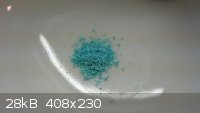 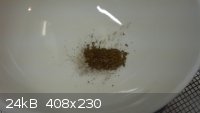 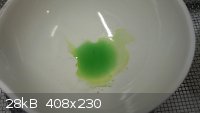 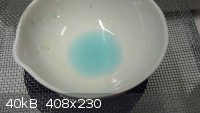
|
|
|
Kola
Harmless

Posts: 13
Registered: 19-2-2012
Location: My Lab
Member Is Offline
Mood: Caustic
|
|
I've once prepared (impure) CuCl2 by electrolysis of a mixture of NaCl and Al2(SO4)3 using Cu electrodes. The aluminium sulphate i added was to ensure
the solution remains acidic. The CuCl2 formed was first green, but later as some Cl- was escaping as CuCl (a side reaction), the solution turned blue
Nothing gets higher than where God dwells. If there is an upper limit to the universe, call it the abode of God
Chemistry is the central science!
My blog:
http://kolathechemist.blogspot.com |
|
|
zoombafu
Hazard to Others
  
Posts: 255
Registered: 21-11-2011
Location: U.S.
Member Is Offline
Mood: sciencey
|
|
I posted this synthesis on my blog if you want to check it out.
http://thehomechemist.com/blog/cucl2synthesis/
|
|
|
jamit
Hazard to Others
  
Posts: 375
Registered: 18-6-2010
Location: Midwest USA
Member Is Offline
Mood: No Mood
|
|
Quote: Originally posted by woelen  | The left vial in your picture almost certainly is quite pure CuCl2.2H2O with some HCl in it. It is a very well-known color for me. If I look at the
picture (assuming color balance on your camera is correct) , then it must be quite pure already, the amount of HCl in it is not large. Just try
heating it a little bit. An acrid smell of HCl almost certainly will be given off.
The brown material definitely is the anhydrous compound. I have made that as well. Add a little of the brown material to water. Does it dissolve to a
green or blue solution? Is the solution 100% clear or somewhat turbid? If the CuCl2 anhydrous is prepared by heating, then it might be that there is a
small amount of oxychloride or even oxide in the sample, due to driving off HCl. A carefully prepared sample, however, will dissolve without any
turbidity.
I cannot make anything of the bright blue compound you have. I have never seen such a compound when based on copper chloride. My sample of copper
chloride becomes green when a drop of water is added to it. Concentrated solutions are green (chloro complexes) and dilute solutions are blue (aqua
complexes). Just a few suggestions:
1) Heat a small sample of the bright blue compound. What color do you obtain? Brown like the anhydrous CuCl2?
2) Dissolve some of the bright blue compound in water. Do you get a clear solution?
3) Add some NaOH solution (just a few drops) to your solution, prepared in (2). Do you get a bright blue precipitate, or a dirty green one? The latter
is obtained if you have high concentration of chloride in solution.
If indeed the blue compound is CuCl2 as well, then I have learned something new. |
I've confirmed that there is a blue crystalline solid form of copper II chloride. Just last week I added HCl to copper II carbonate until fizzing
stopped and filtered and got this deep green solution. If you let it evaporate you will get the green solid. However, if you concentrate it to
supersaturation and then filter again to get rid of any undissolved solids and allow this to stand in a cold fridge, you will get these beautiful blue
crystals from the deep green solution.
I've done this twice and I still don't understand why sometimes it produces green solids and others it crystallizes into a blue diamond shaped
crystals??
See the picture below:
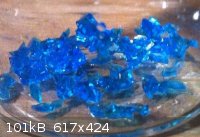
[Edited on 30-3-2012 by jamit]
|
|
|
woelen
Super Administrator
        
Posts: 8079
Registered: 20-8-2005
Location: Netherlands
Member Is Offline
Mood: interested
|
|
This is something I am going to try. I really am surprised by this. Nowehere on the internet one can find info on these blue crystals. Did you boil
down the liquid? Please give some more detail on the exact process and then I can try to reproduce your results.
|
|
|
jamit
Hazard to Others
  
Posts: 375
Registered: 18-6-2010
Location: Midwest USA
Member Is Offline
Mood: No Mood
|
|
Quote: Originally posted by woelen  | | This is something I am going to try. I really am surprised by this. Nowehere on the internet one can find info on these blue crystals. Did you boil
down the liquid? Please give some more detail on the exact process and then I can try to reproduce your results. |
Thanks Woelen for your quick reply. I know through your website that you have done a lot of copper related experiments. What I did was simple. I
used copper II carbonate, which I made with copper sulfate and sodium hydrogen carbonate. I added this to a 31% hardware brand of HCI until it
stopped fizzing. I allowed the reaction to sit for a day. Next I filtered twice using a fine filter paper to remove any copper carbonate or other
insolubles. The solution I collected was about 250ml, deep green and transparent solution, which seems quite concontrated. When I allowed it to sit
for a day, you can see fine particles or dust that has settled to the bottom -- it was missed by the filter paper. I filtered again but only the
clear section of the solution and discarded the dust/insoluble impurities.
Next, I transferred the solution to a clean beaker and left it in my garage for several days. Its winter where I live so its about 5C. I checked
yesterday and notice diamond like crystals. I could have allow it to grow even more but I decanted the solution and collected the crystals to show
off picture above. I'm going to use the seed to grow bigger crystals. I'll post the picture after it gets bigger.
After your previous comments, I just assumed that I must have done something wrong to get "blue" crystals of copper II chloride and that maybe I
confused it with copper II nitrate. But after this result, I'm sure that copper II chloride also exist in this blue crystal form. The solution from
which it came, is deep green, from which I expected green solids.
I'm going to try this experiment again in the next several weeks/months... at least several times. Like you, I've this fixation with copper
compounds. Give it a try... in fact I'm surprise that you've never got this result. Good luck
[Edited on 30-3-2012 by jamit]
|
|
|
jamit
Hazard to Others
  
Posts: 375
Registered: 18-6-2010
Location: Midwest USA
Member Is Offline
Mood: No Mood
|
|
More pictures of my results
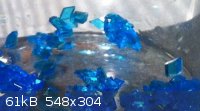
|
|
|
woelen
Super Administrator
        
Posts: 8079
Registered: 20-8-2005
Location: Netherlands
Member Is Offline
Mood: interested
|
|
I'll try the experiment with commercial grade CuCO3 and 30% HCl, just to assure that no impurities like sodium ions or sulfate ions are in the
compounds I use. As soon as I have results I'll let you know.
|
|
|
Dennis SK
Harmless

Posts: 21
Registered: 12-3-2012
Member Is Offline
Mood: No Mood
|
|
Beautiful pictures in this topic!
Thanks for sharing.
|
|
|
blogfast25
International Hazard
    
Posts: 10562
Registered: 3-2-2008
Location: Neverland
Member Is Offline
Mood: No Mood
|
|
This quite interesting. An ambiguous colour ('blue-green') is of course always debatable. Different people may even perceive it differently. The Wiki
photo for CuCl2.2H2O for instance appears more blue than green to me but not as deep blue as Jamit's photos.
|
|
|
| Pages:
1
2
3 |